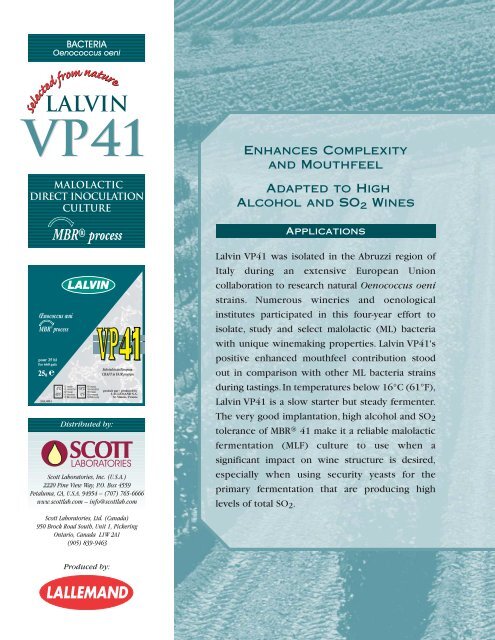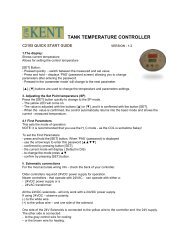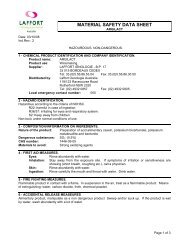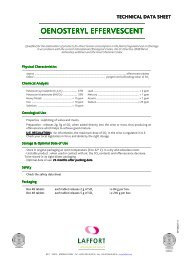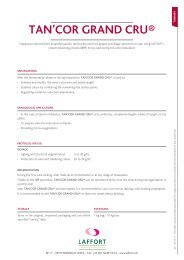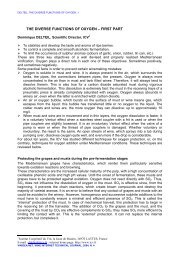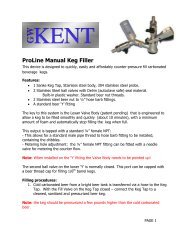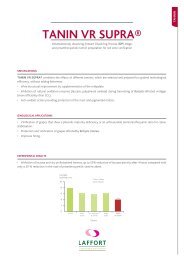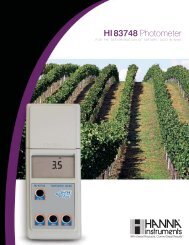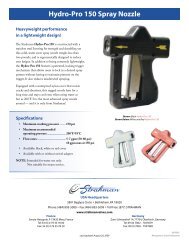Lalvin - GW Kent
Lalvin - GW Kent
Lalvin - GW Kent
Create successful ePaper yourself
Turn your PDF publications into a flip-book with our unique Google optimized e-Paper software.
BACTERIA<br />
Oenococcus oeni<br />
<strong>Lalvin</strong><br />
Selected<br />
Selected<br />
from nature<br />
VP41<br />
Malolactic<br />
DIRECT INOCULATION<br />
Culture<br />
MBR® process<br />
Distributed by:<br />
Scott Laboratories, Inc. (U.S.A.)<br />
2220 Pine View Way, P.O. Box 4559<br />
Petaluma, CA, U.S.A. 94954 – (707) 765-6666<br />
www.scottlab.com – info@scottlab.com<br />
Scott Laboratories, Ltd. (Canada)<br />
950 Brock Road South, Unit 1, Pickering<br />
Ontario, Canada L1W 2A1<br />
(905) 839-9463<br />
Enhances Complexity<br />
and Mouthfeel<br />
Adapted to High<br />
Alcohol and SO 2 Wines<br />
Applications<br />
<strong>Lalvin</strong> VP41 was isolated in the Abruzzi region of<br />
Italy during an extensive European Union<br />
collaboration to research natural Oenococcus oeni<br />
strains. Numerous wineries and oenological<br />
institutes participated in this four-year effort to<br />
isolate, study and select malolactic (ML) bacteria<br />
with unique winemaking properties. <strong>Lalvin</strong> VP41's<br />
positive enhanced mouthfeel contribution stood<br />
out in comparison with other ML bacteria strains<br />
during tastings.In temperatures below 16°C (61°F),<br />
<strong>Lalvin</strong> VP41 is a slow starter but steady fermenter.<br />
The very good implantation, high alcohol and SO 2<br />
tolerance of MBR ® 41 make it a reliable malolactic<br />
fermentation (MLF) culture to use when a<br />
significant impact on wine structure is desired,<br />
especially when using security yeasts for the<br />
primary fermentation that are producing high<br />
levels of total SO 2 .<br />
Produced by:
Oenological and Microbiological Properties<br />
• Pure strain of Oenococcus oeni<br />
• pH tolerance: >3.1<br />
• Wide range of temperature tolerance: 16°-24°C (61°-75°F)<br />
• MLF kinetics: moderate<br />
• Alcohol tolerance: excellent<br />
• Total SO 2 : 50-60 ppm<br />
• Nutrient needs: in difficult conditions, the addition of<br />
Opti-Malo MLF nutrient is recommended<br />
• Low VA production<br />
• Reduction of acetaldehyde content resulting in better<br />
SO 2 efficiency (reduces SO 2 needs)<br />
• Biogenic amine production: very low<br />
Comparison between <strong>Lalvin</strong> VP41 and<br />
<strong>Lalvin</strong> 31 MBR Starter Cultures<br />
Comparison between <strong>Lalvin</strong> VP41 and<br />
<strong>Lalvin</strong> 31 MBR Starter Cultures<br />
EtOH<br />
LALVIN 41<br />
LALVIN 31<br />
pH<br />
3.0<br />
3.1<br />
3.2<br />
3.3<br />
16 15 14 13 12 20 18 16 14 12<br />
30<br />
40<br />
50<br />
60<br />
ºC<br />
LALVIN 41<br />
LALVIN 31<br />
Mouthfeel<br />
Volume<br />
Spicy Notes<br />
5 4 3 2 1 1 2 3 4 5<br />
4<br />
3<br />
2<br />
1<br />
2<br />
3<br />
4<br />
5<br />
Tanin<br />
Intensity<br />
T SO 2<br />
Red Fruit<br />
Usage<br />
Prepared according to the Lallemand MBR® process,<br />
pre-acclimation is achieved during biomass<br />
production, giving bacteria cell-wall resistance to the<br />
adverse conditions found in wine, and allowing easy<br />
and direct wine inoculations.<br />
Simply rehydrate contents of one sachet for 25 hL<br />
(660 U.S. gallons) into 500 mL of clean chlorine-free<br />
water at 20°-30°C (68°-86°F).<br />
To inoculate, add the suspension directly to the wine<br />
towards the end of the alcoholic fermentation, then<br />
stir gently to evenly distribute the bacteria and<br />
minimize the oxygen pickup.<br />
This product can be stored for 12 months at 4°C<br />
(39°F) and 18 months at -18°C (0°F)<br />
Sensory Contribution of <strong>Lalvin</strong> VP41<br />
to Aroma and Wine Structure<br />
Lactic<br />
Vegetal<br />
Tropical fruit<br />
4<br />
3.5<br />
3<br />
2.5<br />
2<br />
1.5<br />
1<br />
0.5<br />
0<br />
Volume<br />
*Lallemand internal results 1998-1999<br />
Classic MBR Malolactic<br />
Starter Culture<br />
<strong>Lalvin</strong> VP41<br />
Varietal<br />
Packaging Sizes<br />
Available in sachets for inoculation of 2.5 hL (66 U.S. gallons), 25 hL (660 U.S. gallons) and 250 hL (6,600 U.S. gallons) of wine.<br />
For More Information<br />
Lallemand has various technical publications at your<br />
disposal. Please visit www.lallemandwine.com for more<br />
information.<br />
Lallemand guarantees the quality of its products sold in<br />
the original packaging, used before the expiration date<br />
and properly stored.<br />
This sheet contains the latest information on our<br />
products. Subjet to change. This information does not<br />
constitute a contract.<br />
S<strong>Lalvin</strong><br />
Selected<br />
elected<br />
nature<br />
from VP41<br />
@<br />
www.lallemandwine.com<br />
11-03
MATERIAL SAFETY DATA SHEET<br />
SECTION I - PRODUCT & COMPANY IDENTIFICATION<br />
Product name:<br />
Product code:<br />
Description:<br />
Product use:<br />
Manufacturer:<br />
Person responsible for marketing within<br />
the community:<br />
Person responsible for MSDS preparation:<br />
Information telephone:<br />
Emergency telephone:<br />
Date of MSDS preparation: Dec 2007<br />
Oenococcus oeni, bacterial cultures, freeze-dried.<br />
Several.<br />
Concentrated bacterial culture, powder.<br />
Bacteria for oenology.<br />
Lallemand Inc, 1620 Prefontaine, Montreal, QUEBEC,<br />
Montreal, Quebec, Canada, H1W 2N8.<br />
Danstar Ferment A.G., Bahnhofstrae 7C.P. 445CH 6301 Zug,<br />
Switzerland.<br />
Lallemand Oenology.<br />
+ 33 5 62 74 55 55<br />
+ 33 5 62 74 55 55<br />
SECTION II - DATA ON COMPONENTS<br />
Product composition:<br />
Microbial concentration:<br />
Hazardous ingredients:<br />
Bacterial culture<br />
> 10 8 CFU/gram<br />
None<br />
Information on bacterial component, as follows:<br />
Name CAS # % by Wt LD 50 & LC 50 OSHA PEL ACGIH TLV<br />
Lactic acid bacterial culture NA Not established Not established Not established<br />
Inactivated saccharomyces cerevisiae NA Not Established Not established Not established<br />
SECTION III – HEALTH HAZARD IDENTIFICATION<br />
Signs and symptoms of overexposure to bacterial powder through primary routes of exposure:<br />
Skin contact: May cause irritation on prolonged contact.<br />
Eye contact: May cause eye irritation upon direct contact. Seek medical attention.<br />
Inhalation: In some cases, repeated exposure may lead to allergic sensitization based on the exposure level,<br />
duration and susceptibility of the individual. Subsequent chronic or acute exposure in sensitized<br />
persons may cause a respiratory allergic reaction in minutes or delayed, or a mixture of both. Typical<br />
symptoms are respiratory irritation, breathlessness, coughing, chest tightness and difficulty breathing.<br />
Ingestion: Excessive ingestion of highly concentrated bacterial powder could lead to intestinal discomfort (e.g.<br />
diarrhea, bloating, cramping, etc.).<br />
SECTION IV – FIRST AID MEASURES (If any symptoms persist, seek medical attention)<br />
Emergency and First aid procedures<br />
Eye contact: Flush eyes for at least 15 minutes.<br />
Skin contact: Wash affected area with soap and water.<br />
Inhalation: Immediately remove person to fresh air.<br />
Ingestion: Drink plenty of water.<br />
Medical conditions likely to be aggravated by exposure: Asthma.<br />
Delayed effect that can be expected after exposure: Unknown.<br />
MSDS Oenococcus oeni rev 06 2009.doc Page 1 of 3
MATERIAL SAFETY DATA SHEET<br />
SECTION V – FIRE FIGHTING MEASURES<br />
Conditions of flammability:<br />
Extinguishing media:<br />
Flash point:<br />
Flammable limits:<br />
Autoignition temperature:<br />
Hazardous combustion products:<br />
Explosion – sensitivity to mechanical impact:<br />
Explosion – sensitivity to static discharge:<br />
Firefighting procedures:<br />
Unknown.<br />
Water, foam, carbon dioxide, dry powder.<br />
Not applicable.<br />
Not applicable.<br />
No data available.<br />
None.<br />
None.<br />
None.<br />
Use self-contained breathing apparatus (SCBA) when exposed to<br />
confined or enclosed fires.<br />
SECTION VI – ACCIDENTAL RELEASE MEASURES<br />
In case material released or spilled, vacuum spill or dilute with water before removal. Collect waste in suitable container and<br />
wash surface with water. Avoid high pressure rinsing. Maintain good housekeeping practices. Biodegradable, may be<br />
discharged into sewer. No special disposal method required, except that it be in accordance with current local,<br />
state/provincial and federal regulations.<br />
SECTION VII – HANDLING & STORAGE<br />
Handling:<br />
Storage:<br />
Avoid breathing dust. Avoid contact with eyes, skin and clothing. Wear protective<br />
equipment described in Section VIII if exposure conditions warrant. Wash thoroughly<br />
after handling.<br />
Refrigerated and dry conditions recommended. Containers should be kept sealed<br />
and dry.<br />
SECTION VIII – EXPOSURE CONTROLS / PERSONAL PROTECTION<br />
Respiratory protection:<br />
Eye contact:<br />
Clothing:<br />
Specific engineering controls:<br />
Environmental exposure control<br />
Protective mask with an assigned protection factor of at least 20 should be worn in<br />
conditions of excessive dusting.<br />
Protective glasses should be worn in conditions of excessive dusting. If eye contact<br />
occurs, rinse with water.<br />
Suitable protective clothing. Follow current Good Manufacturing Practices when handling<br />
food or dietary supplement ingredients and materials.<br />
None.<br />
None.<br />
SECTION IX – PHYSICAL & CHEMICAL PROPERTIES<br />
Microbial concentration:<br />
Physical state:<br />
Appearance:<br />
Odour:<br />
Odour threshold:<br />
Specific gravity:<br />
Vapour pressure:<br />
Vapour density:<br />
Evaporation rate:<br />
Boiling point:<br />
Freezing point:<br />
Melting point:<br />
pH:<br />
Partition coefficient:<br />
Viscosity:<br />
Solubility in water:<br />
Explosive properties<br />
Oxidising properties<br />
> 10 8 CFU/gram.<br />
Solid (powder).<br />
Fine to granular, ivory to beige powder.<br />
Not available.<br />
Not applicable.<br />
No data available.<br />
Not applicable.<br />
Not applicable.<br />
Not applicable.<br />
Not applicable.<br />
Not applicable.<br />
Mixture.<br />
No data available.<br />
Not applicable.<br />
Not applicable.<br />
Partially soluble.<br />
Not applicable.<br />
Not applicable.<br />
MSDS Oenococcus oeni rev 06 2009.doc Page 2 of 3
MATERIAL SAFETY DATA SHEET<br />
SECTION X – STABILITY AND REACTIVITY<br />
Stability:<br />
Incompatibility:<br />
Conditions to avoid:<br />
Materials to avoid<br />
Hazardous decomposition products:<br />
Hazardous polymerization:<br />
Non-reactive (stable under normal conditions of use).<br />
No hazardous incompatibilities. Moisture and high temperatures are<br />
detrimental to microbial concentration of product.<br />
Avoid high humidity.<br />
None.<br />
None.<br />
None.<br />
SECTION XI – TOXICOLOGICAL INFORMATION<br />
Product recognized as safe.<br />
Effects of short-term exposure:<br />
Effects of long-term exposure:<br />
Irritancy:<br />
Sensitization:<br />
Allergy:<br />
Carcinogenicity:<br />
Reproductive toxicity:<br />
Teratogenicity:<br />
Mutagenicity:<br />
Toxicologically synergistic products:<br />
None.<br />
None.<br />
Unknown.<br />
Possible allergic sensitization (see Section III).<br />
May contain dairy and soy products.<br />
No listed as a carcinogen or potential by the NTP, IARC Monographs or OSHA.<br />
Unknown.<br />
Unknown.<br />
Unknown.<br />
Unknown.<br />
SECTION XII – ECOLOGICAL INFORMATION<br />
Adopt good working practices so that the product is not released into the environment.<br />
No ecological information is available. The substance is unlikely to have a significant effect on the environment.<br />
SECTION XIII – DISPOSAL CONSIDERATIONS<br />
Product can be removed and disposed of in regular trash or waste. No special disposal method required, except that it be in<br />
accordance with current local authority regulations.<br />
SECTION XIV – TRANSPORT INFORMATION<br />
Not classified as dangerous in the meaning of transport regulations.<br />
SECTION XV – REGULATORY INFORMATION<br />
WHMIS classification for product:<br />
Not a WHMIS regulated product. Product is classified as NIH (National Institute of<br />
Health, US) Risk Group I and is not considered to fall within the Canadian Controlled<br />
Products Regulations criteria for biohazardous infectious materials.<br />
This product does not meet the definition of a hazardous material given in the U.S.<br />
Occupational Safety and Health Administration’s Hazard Communication Standard.<br />
This product does not require a registration or Chemical Safety Report under EU<br />
Regulation 1907/2006.<br />
The preparation does not contain dangerous ingredients. Refer to the regulations of the country of import.<br />
SECTION XVI – OTHER INFORMATION<br />
The information herein is based on current available data and is believed to be correct. No warranty, express or implied, is<br />
made regarding data accuracy, merchantability or hazards associated with product use. The user is responsible for<br />
determining product suitability, conditions of use and all associated hazards. Values listed in this document are not product<br />
specifications.<br />
MSDS Oenococcus oeni rev 06 2009.doc Page 3 of 3


